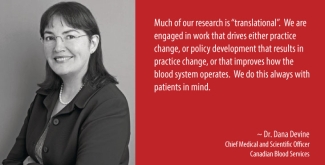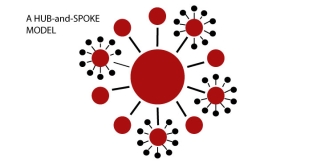“From the perspective of the blood system, our role I believe is to facilitate research that is required to provide patients with the safest and most effective blood and blood products.”

In 2016, the Government of Canada launched an independent review of federal funding for fundamental science with the aim to ensure its support for fundamental research is “coherent, effective and agile enough to keep pace with the dynamic nature of contemporary science.” As an organization that supports fundamental and applied research, Canadian Blood Services participated in this review by submitting a response in late September.
Led by Chief Medical and Scientific Officer, Dr. Dana Devine, we compiled responses to questions under the “Institutions and Administrator” category. With our dedicated resources to blood research and development, we hold a unique position within the Canadian research and healthcare landscapes. Being part of a blood manufacturing organization with tight links to hospital customers, industry partners and academia allows our research activities to be targeted, mission-driven and innovative. Ours is an inter-sectorial model that reaches out nationally and internationally for targeted investment in transfusion (and transplantation) science and medicine. This model and the outcomes it has achieved may hold valuable learnings and experience to inform other national research funding mechanisms.
Mission-driven by intention
Canadian Blood Services was created in 1998 through a memorandum of understanding of the federal, provincial and territorial ministers of health in response to the infection of the blood supply with HIV and HCV — the largest public health tragedy in the country’s history.
“Born out of the contaminated blood tragedy of the 1980s and 90s, the federal money that supports our research and development activities is an intentional allocation to put a research focus on transfusion medicine as a lesson-learned,” explains Dr. Devine.
In the wake of recommendations from the Commission of Inquiry on the Blood System in Canada led by Mr. Justice Horace Krever, our organization was tasked with delivering a national blood system that assures access to a safe, secure and affordable supply of blood, blood products and their alternatives. With the ever-evolving field of transfusion medicine, the need for continued research to ensure the safety and efficacy of the blood system is still very relevant today.
Canadian Blood Services receives research funding in three different ways:
- Through a grant contribution from Health Canada — defined in the original memorandum of understanding — that states the federal government shall provide funding each year for research and development in transfusion science. Canadian Blood Services reports regularly against a rigorous performance measurement framework, and the program undergoes an external evaluation every five years. In addition, for each five-year period, Canadian Blood Services submits a proposal to Health Canada to outline the outcomes and outputs that it commits to deliver.
- The provinces and territories also provide a similar funding contribution in accordance with an agreement on research and development principles. This agreement also requires Canadian Blood Services to report to the provinces and territories on its research progress.
- Canadian Blood Services’ researchers receive additional funding via competitive programs led by various traditional funding agencies as well as via contract research agreements with industry.

Driving our research priorities
Canadian Blood Services’ mission is the guiding principle by which research priority areas are set. In a very deliberate way, in consultation with internal and external stakeholders, we put resources into areas where we believe they can be used to drive innovation and improve the blood system. We do not perform research that cannot be readily or obviously linked to our mandate.
“Much of our research is ‘translational’,” says Dr. Devine. “We are engaged in work that drives either practice change, or policy development that results in practice change, or that improves how the blood system operates. We do this always with patients in mind.”
A hub-and-spoke model — building a better brain trust
Other blood systems have chosen to concentrate research and development activities into one physical location. We went a different way. We chose a distributed research and development model — a hub-and-spoke model — that connects highly accomplished Canadian researchers in the field of transfusion medicine.
We have networked researchers and their labs across the country, integrating scientists from complementary disciplines. They are focused on fundamental, developmental and clinical research. As such, they’ve created a rich fabric of research areas that truly bridge the lab “bench” to the patient “bedside”. Within this model, researchers can interact with their local university research colleagues — thereby extending expertise, knowledge and discovery beyond the confines of one location-based institution.

A great example of this kind of interconnectivity is how Canadian Blood Services and the University of British Columbia are linked through the UBC Centre for Blood Research. Canadian Blood Services was an original contributor to the establishment of the Centre for Blood Research at the University of British Columbia, one of Canada’s centres of excellence in blood research. We also provide support to centres of excellence in transfusion medicine such as current Program Support Award recipients at The Ottawa Hospital and McMaster University.
“Canadian Blood Services’ staff scientists also hold university faculty appointments. They train graduate students and create research collaboratively with other, mostly university-based, professors,” says Dr. Devine. “This creates a broader brain trust of researchers working in transfusion medicine than the isolated research institute model could ever realistically achieve.”
We are fortunate to have a lot of different interests and expertise involved with research that supports the blood system in Canada. The distributed research network allows us to tap into a wealth of research areas, opportunities and individual scientists who are affiliated in various ways with Canadian Blood Services.
Casting a wide net to foster innovation
Canadian Blood Services is focused on identifying the problems that exist in transfusion and transplantation science and medicine. We draw in experts from various disciplines who together can bring innovative thinking to bear on real problems.
“I believe our model is successful because we are focused on specific areas of medicine,” says Dr. Devine “We take advantage of multiple research disciplines and leverage that knowledge to move ahead.”
This model supports convergence of expertise around blood, organs, and hematopoietic stem cells that draws on scientists, physicians, supply chain experts, engineers, computer programmers and more — it’s a multi-disciplinary and integrated approach to building a better system. The Quality Monitoring Program established a decade ago is a great example of effective collaboration with a quality focus directly related to our core mission.
Research in practice — collaboration and a quality focus
While there has been a recognition in research circles that each blood donor is unique and therefore each donation we collect has its own characteristics, our researchers saw a need to deepen understanding of how those characteristics could affect the quality and effectiveness of the blood products we manufacture for Canadian patients.
“More than a decade ago, in the formative years of our research initiatives, we established a program within Canadian Blood Services to perform regular monitoring of some biological characteristics of our blood products.” Dr. Devine explains. “To look at how different they were, depending on where and how they were manufactured. We called this the Quality Monitoring Program. The intention of this work is to ultimately develop better quality standards for blood components.”
This program tapped into expertise from various research hubs across the country: platelets were the focus in Dr. Devine’s research group at the Centre for Blood Research in Vancouver, Dr. Bill Sheffield’s group at McMaster University focused on plasma, and red blood cells were the focus of Dr. Jason Acker and his team at the University of Alberta.
They undertook research projects that looked at the effect of processing blood components on the quality of blood products, meaning the different ways you can make blood products and what the methods of manufacture means to the product quality.
More recently, they’ve asked questions about whether the differences in manufacturing technologies and among donors have an influence on transfusion patient outcomes. Answering those questions required linking Canadian Blood Services’ data about its blood products with data from transfusion patients. Collaborations led by research groups at McMaster University and The Ottawa Hospital were facilitated by Canadian Blood Services — casting the net widely for expertise and resources not available in house with the goal of making sure patients receive the best quality products.
Research findings:
“This work we started over 10 years ago has had huge impact on the transfusion field beyond Canada. There is a lot of discussion about product quality and its impact on patients that wasn’t happening before. Many studies on the differences from one product to another in terms of how you make it or store it are underway around the globe,” says Dr. Devine. “This kind of consciousness-raising can go right back to the first work we started in the Quality Monitoring Program. Our mission-driven strategy has had a big, long-term impact on how transfusion focused researchers look at blood product quality.”
We are also beginning to develop a similar program for cord blood, in the laboratory led by Dr. Nicolas Pineault in Ottawa.
Canada – a focused research future
From a Canadian Blood Services perspective, federal leadership and coordination are essential to identify national priority areas for research such as ours, so that valuable long-lasting integrated partnerships and foundations can be channeled to produce the most national benefit. We are nurturing a network of smart, innovative people whose talent has been focused in one direction since the late 1990s and which will continue to ensure the safety and efficacy of the blood system for Canadians for years to come.
Canadian Blood Services – Driving world-class innovation
Through discovery, development and applied research, Canadian Blood Services drives world-class innovation in blood transfusion, cellular therapy and transplantation — bringing clarity and insight to an increasingly complex healthcare future. Our dedicated research team and extended network of partners engage in exploratory and applied research to create new knowledge, inform and enhance best practices, contribute to the development of new services and technologies, and build capacity through training and collaboration.
The opinions reflected in this post are those of the author and do not necessarily reflect the opinions of Canadian Blood Services nor do they reflect the views of Health Canada or any other funding agency.